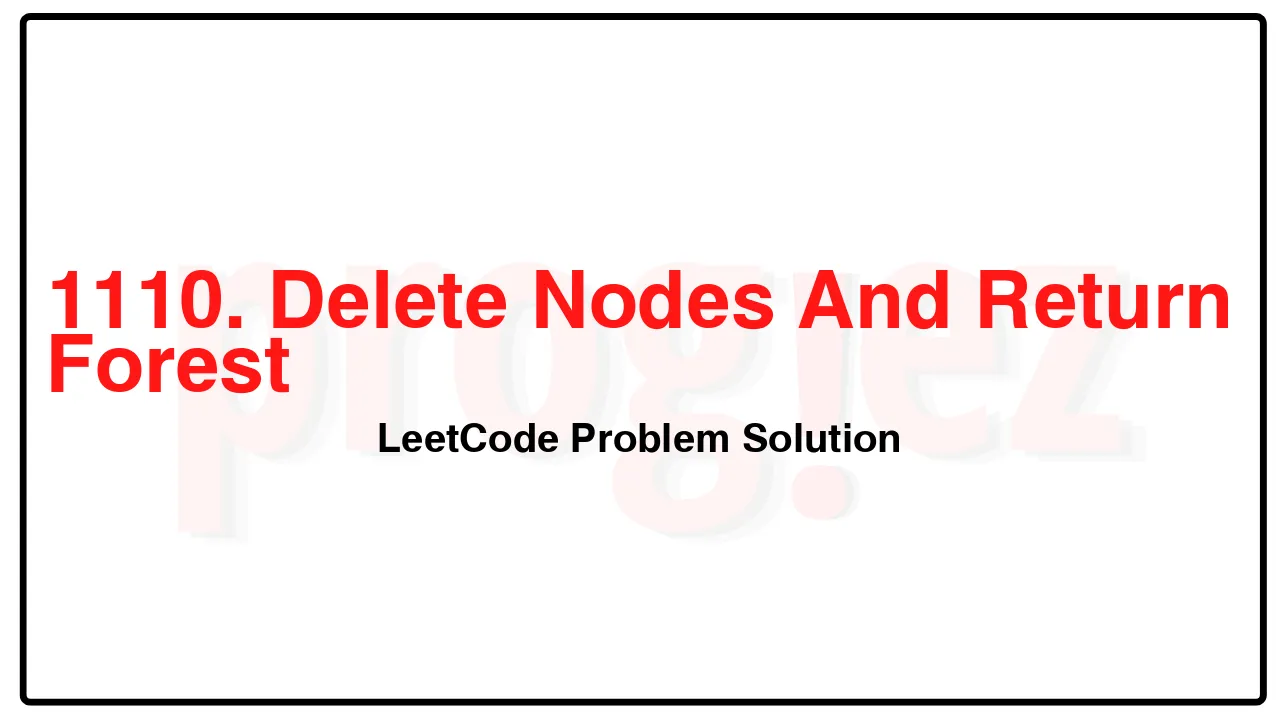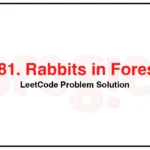1110. Delete Nodes And Return Forest LeetCode Solution
In this guide, you will get 1110. Delete Nodes And Return Forest LeetCode Solution with the best time and space complexity. The solution to Delete Nodes And Return Forest problem is provided in various programming languages like C++, Java, and Python. This will be helpful for you if you are preparing for placements, hackathons, interviews, or practice purposes. The solutions provided here are very easy to follow and include detailed explanations.
Table of Contents
- Problem Statement
- Complexity Analysis
- Delete Nodes And Return Forest solution in C++
- Delete Nodes And Return Forest solution in Java
- Delete Nodes And Return Forest solution in Python
- Additional Resources

Problem Statement of Delete Nodes And Return Forest
Given the root of a binary tree, each node in the tree has a distinct value.
After deleting all nodes with a value in to_delete, we are left with a forest (a disjoint union of trees).
Return the roots of the trees in the remaining forest. You may return the result in any order.
Example 1:
Input: root = [1,2,3,4,5,6,7], to_delete = [3,5]
Output: [[1,2,null,4],[6],[7]]
Example 2:
Input: root = [1,2,4,null,3], to_delete = [3]
Output: [[1,2,4]]
Constraints:
The number of nodes in the given tree is at most 1000.
Each node has a distinct value between 1 and 1000.
to_delete.length <= 1000
to_delete contains distinct values between 1 and 1000.
Complexity Analysis
- Time Complexity: O(n)
- Space Complexity: O(\texttt{h} + |\texttt{toDelete}|)
1110. Delete Nodes And Return Forest LeetCode Solution in C++
class Solution {
public:
vector<TreeNode*> delNodes(TreeNode* root, vector<int>& to_delete) {
vector<TreeNode*> ans;
dfs(root, {to_delete.begin(), to_delete.end()}, true, ans);
return ans;
}
private:
TreeNode* dfs(TreeNode*& root, const unordered_set<int>&& toDeleteSet,
bool isRoot, vector<TreeNode*>& ans) {
if (root == nullptr)
return nullptr;
const bool deleted = toDeleteSet.contains(root->val);
if (isRoot && !deleted)
ans.push_back(root);
// If root is deleted, both children have the possibility to be a new root
root->left = dfs(root->left, std::move(toDeleteSet), deleted, ans);
root->right = dfs(root->right, std::move(toDeleteSet), deleted, ans);
return deleted ? nullptr : root;
}
};
/* code provided by PROGIEZ */1110. Delete Nodes And Return Forest LeetCode Solution in Java
class Solution {
public List<TreeNode> delNodes(TreeNode root, int[] to_delete) {
List<TreeNode> ans = new ArrayList<>();
Set<Integer> toDeleteSet = Arrays.stream(to_delete).boxed().collect(Collectors.toSet());
dfs(root, toDeleteSet, true, ans);
return ans;
}
private TreeNode dfs(TreeNode root, Set<Integer> toDeleteSet, boolean isRoot,
List<TreeNode> ans) {
if (root == null)
return null;
final boolean deleted = toDeleteSet.contains(root.val);
if (isRoot && !deleted)
ans.add(root);
// If root is deleted, both children have the possibility to be a new root
root.left = dfs(root.left, toDeleteSet, deleted, ans);
root.right = dfs(root.right, toDeleteSet, deleted, ans);
return deleted ? null : root;
}
}
// code provided by PROGIEZ1110. Delete Nodes And Return Forest LeetCode Solution in Python
class Solution:
def delNodes(self, root: TreeNode, to_delete: list[int]) -> list[TreeNode]:
ans = []
toDeleteSet = set(to_delete)
def dfs(root: TreeNode, isRoot: bool) -> TreeNode:
if not root:
return None
deleted = root.val in toDeleteSet
if isRoot and not deleted:
ans.append(root)
# If root is deleted, both children have the possibility to be a new root
root.left = dfs(root.left, deleted)
root.right = dfs(root.right, deleted)
return None if deleted else root
dfs(root, True)
return ans
# code by PROGIEZAdditional Resources
- Explore all LeetCode problem solutions at Progiez here
- Explore all problems on LeetCode website here
Happy Coding! Keep following PROGIEZ for more updates and solutions.









